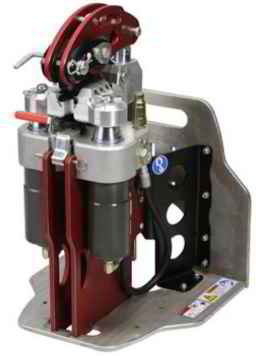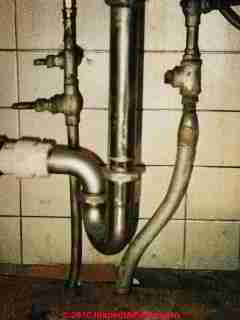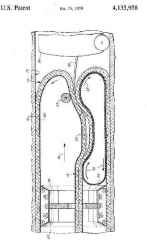 Trenchless Piping Installation & Repair Methods
Trenchless Piping Installation & Repair Methods
- POST a QUESTION or COMMENT about CIPP and other trenchless piping installation & repair methods
CIPP cured in place pipe re-lining repairs:
This article describes & defines CIPP, or cured in place pipe relining: a pipe rehabilitation method used to rehabilitate and thus extend the life of sewer piping, storm drains and also water and gas and process piping. We also define & describe directional drilling or horizontal drilling and we list & describe alternatives to the CIPP method including close-fit pipe, shotcrete, sliplining, and spiral wound pipe for trenchless pipe installation or repair.
CIPP can particularly extend the service life of piping abrasive applications are involved but it is also used in ordinary drain waste piping in sizes ranging from residential sewer lines to municipal and commercial piping. The page top sketch of cured in place piping installation details is adapted from Woods' 1979 US. Patent No. 4135958, "Method of lining a passageway with a resin absorbent tube"
InspectAPedia tolerates no conflicts of interest. We have no relationship with advertisers, products, or services discussed at this website.
Trenchless Pipe Repair Methods
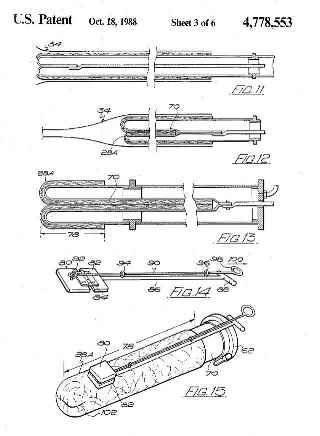 Article Contents:
Article Contents:
CIPP, cured in place pipe re-lining, trenchless pipe repair or replacement, close-fit, shotcrete, sliplining & other methods are discussed here.
- CIPP Cured in Place Pipe rehabilitation or new pipelines
- Closefit pipe relining methods
- Directional Drilling for trenchless new pipe installation
- Shotcrete Relining Method for large diameter drain systems
- Sliplining trenchless pipe repair method
- Spiral wound pipe repair method
- Split & Reline Existing Piping
- CIPP Systems, Providers, Companies
[Click to enlarge any image]
Closefit Pipe Relining Methods
"Closefit" pipe relining refers to inserting a liner into an existing pipeline by deforming and then forcing a liner through the existing pipe.
The new pipe liner may be "structural" - able to withstand external soil and other pressures or forces - or "non-structural" - a liner is inserted inside the pipe to seal it against leakage, but the original pipe is required to withstand external forces.
In some applications the plastic liner used in closefit pipe repairs has been folded into itself to present a smaller external diameter. After the closefit pipe has been inserted through the original pipeline it is un-folded or expande.
After the liner has been inserted the original pipe deformation is reduced, allowing the original pipe to "closely fit" around the new liner, or in an opposite approach, a pipe liner that has been temporarily reduced in diameter is expanded to closely fit into the original pipeline.
An important difference between close-fit pipe relining and sliplining discussed below is that the close fit approach results in a larger diameter pipe at the end of the process than that achieved by routing a slipliner throrough the original pipe.
CIPP: Cured In Place Pipe - pipeline rehabilitation Method
According to the International Society for Trenchless Technology
Cured in Place pipe (CIPP) can be used to rehabilitate sanitary sewers, storm drains and pressure pipelines for water, gas and process effluents. Circular pipe from 100-2,700mm and a variety of noncircular pipe such as egg shapes, ovoids, and box culverts can be lined.
Lining with CIPP removes the pipe from service for the duration of the installation and reinstatement process so overpumping or provision of an alternate source of supply may be necessary. - ISTT 2014 www.istt.com
In turn, "trenchless technology" refers to a panoply of solutions to underground piping or related systems that address repair or installation without having to excavate. Details of how CIPP may be used to re-line existing pipe systems are illustrated from several U.S. patents shown throughout this article. At left is a CIPP detail from Woods' U.S. Patent 4,778,553 from 1988.
The scope of trenchless technology ranges from directional drilling or "horizontal drilling" & boring tools used by your local plumber to route a supply, drain, or other pipe underneath portions of a building, slab, or foundation to large scale municipal sewer line or water supply piping relining such as projects described by ISTT.
Besides CIPP for existing pipeline repairs or relining and horizontal drilling cited above there is a variety of methods including inserting close-fit pipe into an existing pipeline, using shotcrete to reline pipes, sliplining an existing line, and spiral wound pipe.
CIPP or cured in place piping uses a re-lining method typically applied to existing pipelines.
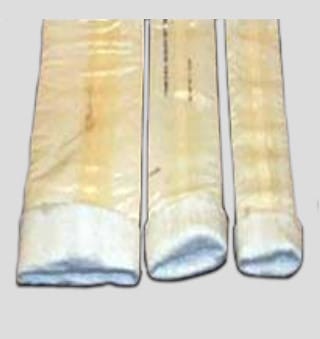 The existing and presumably leaky or soon-to-leak pipeline is cleaned of debris and any connections that intrude into the pipeline must be removed (which means some excavation may be required).
The existing and presumably leaky or soon-to-leak pipeline is cleaned of debris and any connections that intrude into the pipeline must be removed (which means some excavation may be required).
A liner material of synthetic fabric (non-woven polyester or fiberglass) is impregnated with resin (think slow-curing epoxy) and is forced into the pipeline, then expanded by air or water pressure.
Illustrated at left is a reinforced synthetic fabric pipe liner used by Insta-Pipe, Tumwater WA, USA.
When the CIPP liner is in place, curing time is reduced by circulating hot water through the piping or by pulling a UV light through the pipe. Curing time ranges from an hour to 30 hours.
It should be no surprise that CIPP is described by ISTT, the International Society for Trenchless Technology, as CIPP was first implemented in London in 1971. CIPP was patented by Eric Wood in the U.S. in 1977 and entered the public domain in 1994. Mr. Wood holds a number of related patents - see - Wikipedia retrieved 2/20/2014. Wood's patent describes the procedure as follows:
The invention provides a method of applying a resin impregnated lining sleeve to a length of passageway surface wherein the sleeve first of all has a carrier tube everted into the sleeve from one end and out of the other end, the carrier tube is re-inverted to draw the sleeve into the carrier tube and then the assembly of carrier tube and sleeve is positioned in relation to the passageway length to be lined and the carrier tube re-everted to position the sleeve on the surface in the required position. The resin is subsequently cured and the carrier tube removed leaving a hard tubular lining shell on the passageway surface. - U.S. Patent No. US4778553 A 1988, Eric Wood
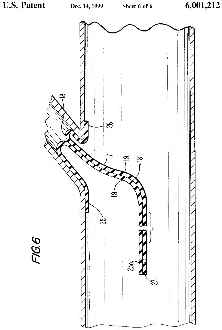 Related inventions and patents related to CIPP include work and patents by Guilio Catallo, Hermann Suerbaum (Method of softlining sewer rehabilitation
US 5280811 A), Richard Carl Polivka, David K. York, (Method for lining of lateral pipelines with flow-through apparatus
US 6001212 A), and others. Quoting from Polivka we and noting their patent illustration (left) adds this interesting detail:
Related inventions and patents related to CIPP include work and patents by Guilio Catallo, Hermann Suerbaum (Method of softlining sewer rehabilitation
US 5280811 A), Richard Carl Polivka, David K. York, (Method for lining of lateral pipelines with flow-through apparatus
US 6001212 A), and others. Quoting from Polivka we and noting their patent illustration (left) adds this interesting detail:
An apparatus for the installation of an inverted resin impregnated flexible tubular liner in a lateral passageway from a main passageway while permitting the flow of fluids through the main passageway during the installation process is provided.
A cylindrical body with an opening to coincide with and interact with the lateral passageway has an expandable bladder on its outside with an opening coincident with the body opening and an elbow portion on the inside which is firmly attached at the opening.
An air supply inflates the bladder. A tubular elbow is attached to a flexible hose at its proximal end, the hose having a gland for injecting fluid into the hose for inverting and curing the liner. - Richard Carl Polivka, David K. York, (Method for lining of lateral pipelines with flow-through apparatus US 6001212 A), 1999
Directional Drilling for trenchless new pipe installation
Directional drilling, also referred to as horizontal drilling or lateral drilling, is used to install underground piping by drilling a pilot hole followed by a drilling system that inserts or creates an underground pipe in the drill opening.
Orignated in the oil and gas industry as a method for drilling oil and gas wells these methods have also been adapted for smaller scale residential and commercial applications of more modest needs like getting a pipe under a sidewalk or beneath a building foundation without having to excavate and destroy part of the building to run the pipeline.
Openings and ultimately the pipe diameter used for building and mechanical-system related directional drilling applications such as water piping or sewer piping can reach from seven to a thousand feet and can insert pipes ranging in diameter from 1.5 to 8.5 inches.
Above is a simple dry-core drill used for short horizontal drilling applications.
Shotcrete Relining Method for large diameter drain systems
The shotcrete method of pipe relining is used on large diameter systems such as storm drains. A layer of concrete is formed by spraying wet or dry concrete against the interior of the piping or storm rain system. The shotcrete application method is also properly called pneumatically-applied concrete. Describe by industry expert, Shotcrete describes their process as follows:
We successfully and efficiently re-line corrugated steel drain pipes to extend their life. By filling in the missing and damaged sections of the invert and lining the pipe with a 1 inch thick high strength shotcrete, soil erosion beneath the culvert and road is prevented and the life expectancy of the pipe and the roadway is extended. This is the fastest, most effective, non-disruptive method to repair failing storm drains or to extend the life of newer ones. The pipe is usable 24 hours after lining.
Using a remote controlled track robot mounted with CCTV cameras and a rotary applicator allows us to bring the concrete hose and application equipment to the point of placement eliminating the need for confined space entry and all the restrictions and safety issues related to it.
The proprietary mix that we use allows this high strength shotcrete to develop a compressive strength of 6000+ PSI in 7 days. Engineering studies have indicated a 1-inch thick lining of this material on the inside of the pipe will improve the load carrying capability to H80. - Shotcrete (2014), http://www.shotcretetechnologies.com/cementitiouslinings.html
Wikipedia points out that
Gunite was, at one time, a trademarked name that specifically refers to the dry-mix shotcrete process. In the dry-mix process, the dry sand and cement mixture is blown through a hose using compressed air, with water being injected at the nozzle to hydrate the mixture, immediately before it is discharged onto the receiving surface. ... The concrete mixture is by pneumatic pressure from a gun, hence "gun"-ite.
The term "Gunite" became the registered trademark of Allentown Equipment, the oldest manufacturer of gunite equipment. Other manufacturers were thus compelled to use other terminology to describe the process such as shotcrete, pneumatic concrete, guncrete, etc. - Wikipedia entry on Shotcrete, retrievef 2/20/2014, original source: http://en.wikipedia.org/wiki/Shotcrete
Spiral Wound Pipe Repair Method
The spiral wound pipe repair method was developed to address pipe repairs on existing piping systems whose diameter was either too small or too large for the CIPP or similar pipe relining methods discussed here.
A winding machine produces a new pipe from a plastic strip by either pushing or pulling the growing spiral-wound pipe through the water or sewage infrastructure being rehabilitated. - Formadrain (2014) - http://www.formadrain.com/pipe-renovation-with-spiral-wound-pipe-liners/
Formadrain asserts that this approach produces a minimum reduction in the diameter of the original pipe. In Australia spiral wound pipe repair equipment is provided by Kembla Waterch. The company's product line includes spiral reliner products that can handle diameters from 225mm to 2.5m. Kembla describes the spiral wound pipe re-lining process in this detail:
Kembla’s spiral wound pipe slip lining (SWP SL) system comprises a method whereby a pipe or liner is formed in-situ by spirally winding a PVC profile strip into a host pipe normally from an existing manhole.
A major advantage of this system is that because there is a hollow opening along the entire length of spiral wound pipe at all times then sewer over pumping is not normally required and emergency flow situations can be accommodated by simply stopping work and allowing the flow to discharge through the opening in both the winding machine and the SWP SL pipe.
The T-Ribbed PVC profile strip is brought to site on a large spool. The special winding machine is set up in the base of the access chamber or pit in line with the existing pipe. The winding machine can be dismantled into components and re-assembled in the chamber if the opening is too small. The plastic strip is fed down into the machine which spirally winds it into the required diameter.
As the spiral wound pipe exits the machine it is propelled into and along the existing pipe. The process continues until the other access is reached. The small annulus space between the SWP SL pipe and the existing sewer is then grouted to complete the installation. - Kembla Watertech (2014) http://www.kemblawatertech.com.au
Split & Reline Existing Piping
A different approach to trenchless pipe repair for existing pipelines inserts equipment to split an existing pipe, permitting a replacement liner to be drawn through the original pipe opening. Below is Spartan Tool's Trenchless Pipe Replacement equipment.
This trenchless pipe repair and replacement system allows 2"-6" pipe replacement with up to three 45-degree bends in the pipe and can even upsize from 4" to 6" pipes. ... Spartan Tool’s Water Line Slitters make quick work of one of your most common jobs – replacement of old and failed water lines.
Simply feed the included cable through the existing water line, attach a replacement line to trailing “carrot”, and tug the slitting head through the line, replacing it seamlessly in the same location as the original line. Very little digging, no trenching, and in a matter of minutes you’re ready to hook up the new service! - spartantool.com 2014
Directional or horizontal drilling will be used where there is not an existing pipeline and has its origins in the oil and gas industries where very large distances are drilled for those purposes.
But in infrastructure piping systems such as installing a pipe below an existing building foundation, slab, or a sidewalk, similar if more modest methods and equipment accomplish a similar function
Sliplining Pipe Repair Method Description
The sliplining approach to repair of existing pipelines uses a liner that is drawn or inserted through the original pipeline. The slip-liner must be of smaller diameter than the pipe it is to line, leaving adequate space inside the original pipe to insert the new liner. Hobas, an industry expert describes the process:
During installation, the pipes are pushed or pulled into the existing pipeline and the remaining annular space between the host and liner pipes is filled with pressure resistant grouting, usually a mixture of binding materials. This fixes the inserted pipe in position, creating a pipeline of the same integrity as a new one.
The relining process involves pushing or pulling the new pipes into the existing pipeline and filling the remaining annular space between the host and liner pipes with pressure-resistant grouting, usually a mixture of binding materials. This fixes the inserted pipe in position, making it fit to take over the complete structural load capacity. HOBAS Relining Pipes are particularly suitable for pipe rehabilitation, as they are of low weight, corrosion resistant, quality assured, easy to install and resist the load from the grouting. - Hobas (2014) www.hobas.com
Resources for Trenchless Pipe Repair: methods, equipment sources
In addition to citations atReferences or Citations see
- Aqua-Pipe,
Aqua-Pipe/Sanexen Environmental Services Inc.,
200-9935, De Châteauneuf Street,
Entrance 1,
Brossard (Quebec)
Canada
J4Z 3V4
Tel: 1 (800) 263-7870 Email : info@aqua-pipe.com
or in the U.S. at
Sanexen - Affiliated Company, 8505 Mountain View Lane, Unit B, Littleton, CO 80135 , Telephone: Toll free: 800.263.7870 Email: info@aqua-pipe.com - Ditch Witch, 1959 W. Fir Ave. P.O. Box 66 Perry, OK 73077-0066, Tel: 800-654-6481 - USA, Trenchless ditch witch products, Website: http://www.ditchwitch.com
- Epoxy pipe re-lining methodsfor water pipes are discussed at RADIANT SLAB TUBING LEAKS
- Formadrain, Inc. 10121 Parkway Montreal, QC H1J-1P7 Tel: 888-337-6764 , EMAIL: steven@formadrain.com, Website: http://www.formadrain.com. The company produces CIPP and spiral wound piping repair systems.
- HOBAS Engineering GmbH Pischeldorfer Strasse 128 9020 Klagenfurt Austria, Tel.: +43 463 482424 Email: info@hobas.com, Hobas has offices worldwide. Website: www.hobas.com
- Hobas Australia: HOBAS Australia Global Pipe Australia Pty Ltd Unit 1, 27 Metrolink Circuit Campbellfield, VIC 3061 Australia T +61 3 9305 0600 holman.andy@globalpipe.com.au www.hobas.com.au
- Hobas Latin America: HOBAS América Latina Rua Voluntários da Pátria, 1376 Santana | São Paulo | SP-Brasil Cep. 02010-200 CEL BRA +55.11.99364 5995, Email: barbara.prommegger@hobas.com
- Hobas USA: HOBAS Pipe USA 1413 Richey Road Houston Texas 77073 | USA T +1.281.821 22 00 F +1.281.821 77 15 hobas.usa@hobas.com www.hobaspipe.com
- Insta-Pipe - Trenchless Pipe Repair 855 Trosper Road 190-204 Tumwater, WA 98512, Tel: 1-866-463-9747,Website: http://www.insta-pipe.com/
- ISTT, International Society for Trenchless Technology, 15 Belgrave Square, London SW1X 8PS, United Kingdom, Tel: 01-703-299-8484, Website: http://www.istt.com
- Kembla Watertch (Head Office), Sydney 72-76 Cosgrove Rd Strathfield South NSW 2136 ph: (02) 8732 2222, . The company has additional offices in Brisbane, Melbourne, and Rockhampton. Tel: 1800 803 861 Website: http://www.kemblawatertech.com.au
- Shotcrete Technologies, Inc. 1431 Miner Street P.O. Box 3274 Idaho Springs, CO 80452 Phone: 303.567.4871 Fax: 303.567.4605 info@shotcretetechnologies.com , Website: http://www.shotcretetechnologies.com
- Spartan Tool L.L.C. 1506 West Division Street Mendota, IL 61342, U.S. Tel: 1-800-435-3866, Email: customerservice@spartantool.com, Website: http://www.spartantool.com
Trenchless Pipe Residential Applications Q&A
Reader Question 2/19/2014 teri said:
Almost 2 years ago i had the drain line below my bathroom lined with CIPP. ever since that time i have had a moisture problem in my bathroom. after showering in the morning, i hang my towel on the rack, come home after working 8 hours and the towel is still damp. my toilet tissue is always 'damp' feeling and lots and lots of mildew, which i never had prior. there is no exhaust fan, but there never has been, there is a window and this house was built in 1950. could it be possible, when the plumber performed the CIPP that he blocked off the vent pipe that leads from the sewer line thru the roof? my paint is peeling off my walls in the bathroom on the wall that the shower toilet and sink are on. help please !
Reply: Teri, the CIPP that I know about is described by ISTT as:
CIPP Lining
Cured in Place pipe (CIPP) can be used to rehabilitate sanitary sewers, storm drains and pressure pipelines for water, gas and process effluents. Circular pipe from 100-2,700mm and a variety of noncircular pipe such as egg shapes, ovoids, and box culverts can be lined. Lining with CIPP removes the pipe from service for the duration of the installation and reinstatement process so overpumping or provision of an alternate source of supply may be necessary.
From your note I understand that you had some sort of drain treatment like this. We're talking about fixing a plumbing drain, presumably to stop it from leaking. By no means would stopping a drain leak explain an excessive bathroom moisture problem. On the contrary that ought to reduce bath moisture if in the process we stopped leaks from leaving water under the building.
The only relationship between a CIPP drain line repair and increased bath moisture that occurs to me is listed as item 4 in my notes below:
Here are some things to check:
1. How is the bathroom ventilated? As there is no working exhaust fan, only ventilation by opening a window can reduce moisture and the effectiveness of that approach varies by season and window use and the ability of air to enter and exit the bathroom.
2. Is the bathroom window (which permits omission of an exhaust fan in some jurisdictions) actually operable, and if so is it opened to ventilate the bathroom? When, for how long=?
3. Had the use of the bathroom changed in some way: long hot showers?
4. Did the CIPP installation (or some other event) damage or block or disconnect the vent piping system? A clogged vent or a vent that leaks could cause poor drain performance (you'd hear gurgling for example) and a disconnected vent could vent moisture into the building floor or walls depending on where the opening occurs.
More about the diagnosis and cure of indoor moisture problems is at MOISTURE PROBLEMS: CAUSE & CURE.
Epoxy for Leaky or Lead Pipe Re-conditioning & Re-Lining Options
Reader comment: Ace DuraFlow ePipe® Restoration Services for deteriorated or clogged piping
2016/03/21 Bill said:
Have you become familiar with Ace Duraflo's EPipe solution? I encourage you to check it out as it is a much more cost effective way of dealing with both residential lead issues and pin hole leaks. You will also discover they are doing considerable relining of lead service pipes in the UK.
This comment appeared originally at LEAD PIPES in BUILDINGS
Reply:
Ace DuraFlow EPipe is a procedure using a combination of heating, drying and cleaning (sanding) the interior of deteriorated piping followed by installation of an epoxy liner inside the pipe. The system is used in the North America, U.K., and other countries. The company's website does not (that I could find) provide much detail, cost comparisons, research or much technical information but the procedure indeed may be suitable for some piping problems depending on the pipe condition. The company notes that their process is suitable for domestic water systems (galvanized, copper, and PEX piping) and non-potable systems.
The company provides a web pages listing plumbing code and other approvals for their epoxy pipe re-lining procedure for the U.S., Canada, Latin America, the U.K., the E.U., and other countries.
Research about the long term potability of water flowing through epoxy-lined piping may bear a look.
- Ace DuraFlow, CompanyEpipeInnovationShowcaseNewsFind an InstallerAffiliatesContact 3122 West Alpine Street, Santa Ana, CA 92704 Phone: 714-564-7600Toll Free: 800-359-6369, Website: http://www.aceduraflo.com/ U.S.A. & U.K. [?] Tel: 888-775-0220
- ANSI/NSF std61 - National Sanitation Foundation, listed Standard 61, immediate return to service hot and cold potable water pipes.
- ePIPE® complies to the requirements of regulation (EC) No 1935/2004 of the European parliament. ePIPE® is verified as suitable for use in hot and cold rated drinking water pipes. Additional per country approvals include Spain, Belgium, Finland, Sweden, and Romania
- ePIPE® is approved for use for in-situ application for hot and cold domestic water contact in pipes having an internal diameter from 12mm (1/2") with a 2 hour return to service under the Water Regulations Advisory Scheme (WRAS).
- ePIPE meets requirements of Reg. 31(4)(a) for in-situ application to public water supplies. Water pipes having an internal bore, as small as 12mm (1/2”), can be restored, in-place, with a 2 hour ready to return to service time using the patented ePIPE system.
Also see
- Alben, K., Bruchet, A., and Shpirt, E., (1989) Leachate from Organic Coating Materials Used in Potable Water Distribution Systems. Denver, CO, AWWARF
- AWWA (2002) AWWA standard for spray applied in situ epoxy lining of water pipelines – draft.
ANSI/AWWA CB1X-xx. Denver: AWWA - Autret, E., Saisset-Costel, C., Khahil, A., Diagouraga, B., Boireau, A. (1999) In situ resin lining of potable water mains: a comprehensive approach for process optimization and product performance assessment. Pipeline Protection. 37, 207-214.
- Bae, B., Jeong, J., Lee, S. (2002) The quantification and characterization of endocrine disrupter bisphenol-A leaching from epoxy resin. Water Science and Technology. 46, 381-387.
- Conroy, P., Hughes, D., Wilson, I. (1993) Demonstration of an innovative water main rehabilitation renewal technique: in situ epoxy lining. Denver: AWWA
- Jackson, P., Warren, I., James, H. (2007) The long term migration of substances from in-situ applied epoxy resin coatings: final report to the drinking water inspectorate.
- LEAD PIPES in BUILDINGS at InspectApedia.com
- Oram, P., Brown, D., Jennings, K. (2002) The benefits of lining large diameter pipes with polyurethane. International Water Engineering. 22, 52-55.
- Pierce, Ryan, "Impact of an Epoxy Pipe Lining Material on
Distribution System Water Quality", [PDF] Thesis submitted to the faculty of the Virginia Polytechnic Institute and State University in
partial fulfillment of the requirements for the degree of
Master of Science in Environmental Engineering, (2009), University of Vermont, USA, retrieved 2016/03/21, original source: https://theses.lib.vt.edu/theses/available/etd-05242009-231445/unrestricted/THESIS_Revised.pdf
Abstract:
Corrosion of iron and copper pipes can produce leaks and loss of efficiency in the water distribution system, elevate levels of contaminants at the tap, and cost billions of dollars annually in pipe replacement or rehabilitation. In situ pipe rehabilitation using cement mortar, polyurethane, and epoxy is a commonly employed method of dealing with aging yet structurally sound pipes because it is less expensive and less invasive than replacing pipe infrastructure.
Although epoxy has been shown to be an effective solution to pipe corrosion, little research has been conducted regarding its impact on a comprehensive list of water quality parameters. This research addressed that gap in the literature by conducting short-term immersion tests in which new epoxy linings were exposed to reference tap waters containing one of three disinfectant treatments: no disinfectant, free chlorine, or chloramines.
As a comparison, an aged epoxy-lined field sample was also tested. Water exposed to the liners under stagnant conditions was analyzed for the following water quality parameters: pH, ammonia, alkalinity, hardness, metals, disinfectant consumption, total organic carbon (TOC), semi-volatile organic compounds (SVOCs), disinfectant byproduct (DBP) formation, and odor.
Results of the study showed relatively low impacts on water quality, as all USEPA drinking water regulations were met. Impacts were highest during the first 24 hour exposure period during which time significant disinfectant consumption was shown (> 90% free chlorine consumed, 13% chloramines consumed), high TOC was leached (2.6-6.2 mg/L), trihalomethanes and haloacetic acids were formed (both < 15 ug/L), Bisphenol-A, an endocrine disrupter, was detected (< 35 ug/L), and odor was reported by panelists at a moderate intensity and described as sweet/chemical/burning/chlorinous. Impacts were much less after the initial 24 hours, although odor remained noticeable throughout the 30 day study. Overall, water quality impacts were greatest in chlorinated waters and both new and aged epoxy showed slight differences in results. - Saegrov, S., Bjorgum, A., Rodum, E., Haugen, M., Wermskog, L., Reksten, K. (2007) Degradation of lining systems for drinking water networks. Presentation LESAM 2007.
...
Continue reading DRAIN & SEWER PIPING or select a topic from the closely-related articles below, or see the complete ARTICLE INDEX.
Or see these
Recommended Articles
- TRENCHLESS SEWER REPLACEMENT for a discussion of using trenchless pipe technology for replacing failed septic drainfield piping
- RADIANT SLAB TUBING LEAKS where we discuss epoxy pipe lining repairs
- SEWER / SEPTIC PIPE CAMERAS
Suggested citation for this web page
CIPP PIPE LINING REPAIRS at InspectApedia.com - online encyclopedia of building & environmental inspection, testing, diagnosis, repair, & problem prevention advice.
Or see this
INDEX to RELATED ARTICLES: ARTICLE INDEX to PLUMBING SYSTEMS
Or use the SEARCH BOX found below to Ask a Question or Search InspectApedia
...
Ask a Question or Search InspectApedia
Try the search box just below, or if you prefer, post a question or comment in the Comments box below and we will respond promptly.
Search the InspectApedia website
Note: appearance of your Comment below may be delayed: if your comment contains an image, photograph, web link, or text that looks to the software as if it might be a web link, your posting will appear after it has been approved by a moderator. Apologies for the delay.
Only one image can be added per comment but you can post as many comments, and therefore images, as you like.
You will not receive a notification when a response to your question has been posted.
Please bookmark this page to make it easy for you to check back for our response.
Our Comment Box is provided by Countable Web Productions countable.ca
Citations & References
In addition to any citations in the article above, a full list is available on request.
- "Directional Drilling Technology", U.S. EPA, retrieved 2/20/2014, original source: www.epa.gov/cmop/docs/dir-drilling.pdf
- "On Grade Operators Manual", Ditch Witch, 1959 W. Fir Ave. P.O. Box 66 Perry, OK 73077-0066, Tel: 800-654-6481 - USA, Trenchless ditch witch products, Website: http://www.ditchwitch.com
- HOBAS Engineering GmbH Pischeldorfer Strasse 128 9020 Klagenfurt Austria, Tel.: +43 463 482424 Email: info@hobas.com, Hobas has offices worldwide. Website: www.hobas.com
- Hobas Australia: HOBAS Australia Global Pipe Australia Pty Ltd Unit 1, 27 Metrolink Circuit Campbellfield, VIC 3061 Australia T +61 3 9305 0600 holman.andy@globalpipe.com.au www.hobas.com.au
- Hobas Latin America: HOBAS América Latina Rua Voluntários da Pátria, 1376 Santana | São Paulo | SP-Brasil Cep. 02010-200 CEL BRA +55.11.99364 5995, Email: barbara.prommegger@hobas.com
- Hobas USA: HOBAS Pipe USA 1413 Richey Road Houston Texas 77073 | USA T +1.281.821 22 00 F +1.281.821 77 15 hobas.usa@hobas.com www.hobaspipe.com
- Insta-Pipe - Trenchless Pipe Repair 855 Trosper Road 190-204 Tumwater, WA 98512, Tel: 1-866-463-9747,Website: http://www.insta-pipe.com/
- ISTT, International Society for Trenchless Technology, 15 Belgrave Square, London SW1X 8PS, United Kingdom, Tel: 01-703-299-8484, Website: http://www.istt.com
- Spartan Tool L.L.C. 1506 West Division Street Mendota, IL 61342, U.S. Tel: 1-800-435-3866, Email: customerservice@spartantool.com, Website: http://www.spartantool.com
- "Method of lining a passageway with a resin absorbent tube US 4135958 A", Published 23 January 1979, Inventor, Eric Wood, quoting: A lining comprising a resin absorbent tube having on the outside a fluid impermeable membrane everted into the passageway to line same using fluid pressure. The resin absorbent material is soaked in resin by trapping a quantity of resin in the lining before it everts in the passageway, and the resin is cured after the lining is everted into the passageway surface, preferably by a curing means following the everting lining along the inside of the passageway.
- Water quality and aquatic toxicity impacts of CIPP sites from the ASCE Journal of Environmental Engineering: Whelton, A., Salehi, M., Tabor, M., Donaldson, B., and Estaba, J. (2013). ”Impact of Infrastructure Coating Materials on Storm-Water Quality: Review and Experimental Study.” J. Environ. Eng., 139(5), 746–756.
- Wikipedia Web: https://www.wikipedia.org/ provided background information about some topics discussed at this website provided this citation is also found in the same article along with a " retrieved on" date. NOTE: because Wikipedia entries are fluid and can be amended in real time, we cite the retrieval date of Wikipedia citations and we do not assert that the information found there is necessarily authoritative. Entry on Cured In Place Pipe retrieve 2/20/2014, original source: http://en.wikipedia.org/wiki/Cured-in-place_pipe
- In addition to citations & references found in this article, see the research citations given at the end of the related articles found at our suggested
CONTINUE READING or RECOMMENDED ARTICLES.
- Carson, Dunlop & Associates Ltd., 120 Carlton Street Suite 407, Toronto ON M5A 4K2. Tel: (416) 964-9415 1-800-268-7070 Email: info@carsondunlop.com. Alan Carson is a past president of ASHI, the American Society of Home Inspectors.
Thanks to Alan Carson and Bob Dunlop, for permission for InspectAPedia to use text excerpts from The HOME REFERENCE BOOK - the Encyclopedia of Homes and to use illustrations from The ILLUSTRATED HOME .
Carson Dunlop Associates provides extensive home inspection education and report writing material. In gratitude we provide links to tsome Carson Dunlop Associates products and services.



